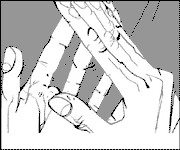THE PIECE WAS Lou Harrison’s Suite for Violin and String Orchestra; the occasion, the May 17 performance of the Seattle Symphony’s Fusion Festival; the soloist, violinist Maria Larionoff. The first movement of the suite ends with a long, high, slow, soft passage for solo violin, which Larionoff played marvelously—and which a good part of the audience chose, understandably, to recognize with applause. But once the precedent was set, the trouble began. Each subsequent movement was also applauded—not the original spontaneous response but a tentatively self-conscious one. And again the audience was faced with the unnecessarily worrisome issue of Applause Between Movements.
No other aspect of concertgoing, surely, fills the novice with such unease. At first, the answer seems simple: It’s customary not to applaud between movements of an extended multimovement classical work. That is, wait till the whole thing’s done, and if you’re unsure of which movement is last, just don’t clap at all until you hear someone else start. But is it ever OK not to observe this custom? The situation is complicated by the fact that knowing the custom is invested with such significance.
Recognizing when to applaud is considered by many a litmus test of musical sophistication; violations are not merely mistakes, but serious and telling gaffes indicating the depth of a concertgoer’s boorishness. I’d say the depth of boorishness is inflicting such a litmus test in the first place. The appropriateness of applause depends on its context. What purpose, really, does an inflexible never-applaud-till-the-end rule serve, other than to stroke the egos of those who know and follow it? The usual argument is that applause breaks whatever sense of musical continuity and unity a composer establishes among the various sections of a larger whole. But often enough the composer seems not to care, especially when providing an inner movement with a blazing climax.
The rousing march that Tchaikovsky placed third among the four movements of his Sixth Symphony is a notorious clap trap. What sort of continuity did he intend between this ending and the lamenting opening of the final slow movement? It’s not applause per se but any intra-movement loss of tension (sustaining which is the conductor’s responsibility) that interrupts the ironic contrast of mood. (Speaking of Tchaikovsky, I once heard the teenage violin prodigy Alyssa Park receive not just applause but a standing ovation after dazzling an audience with the first movement of the Violin Concerto.)
HOW MUCH DAMAGE could a heartfelt outburst honoring a particularly well-played movement inflict on an overall performance? Once at a Cincinnati Chamber Orchestra concert, the group played the slow movement of Janacek’s Idyll so breathtakingly that many in the audience (and there are few audiences more tradition-bound than Cincinnati’s) were moved to forget the rule–a spontaneous show of thanks as lovely as the music itself. On the other hand, any applause after the slowly ebbing, crushingly tragic end of Mahler’s Symphony no. 9 seems grotesque. Kind of like applauding an actual death.
What kinds of classical audiences tend not to observe the no-applause convention? At regular-season orchestra concerts, you rarely hear any stray applause; at special-event or pops concerts, it can happen. Opera fans can be the most demonstrative, even sometimes indulging in catcalls (though on the other hand, Seattle Opera audiences are a bit more reticent than most with standing ovations). Vocal recitals can be problematic—the audience is generally split between punctilious art-song connoisseurs and opera-fan celebrity worshippers enjoying a diva love fest. Yet a song cycle is just where internal applause can become most irritating–sitting through a full round of applause after each of a set of six two-minute songs is grueling. Chamber music audiences seem to be most respectful of the custom, maybe because classical music newbies tend to approach the art form via orchestral concerts and discover chamber music later, after they’ve been intimidated into learning the rule.
Still feeling unsure as you look ahead to the etiquette minefields of this summer’s generous chamber music offerings? Don’t worry, your fellow listeners will gladly enlighten you. At a local recital, I was once literally hit—twice, on the knee, noisily, with a rolled-up program—for applauding the slow movement of Schubert’s String Quintet, despite the fact that it had been one of the most stunning performances of that movement I’d ever heard. Obviously the guy who hit me didn’t agree.







